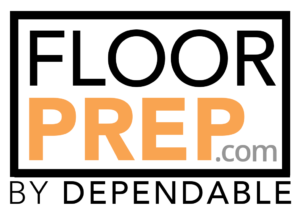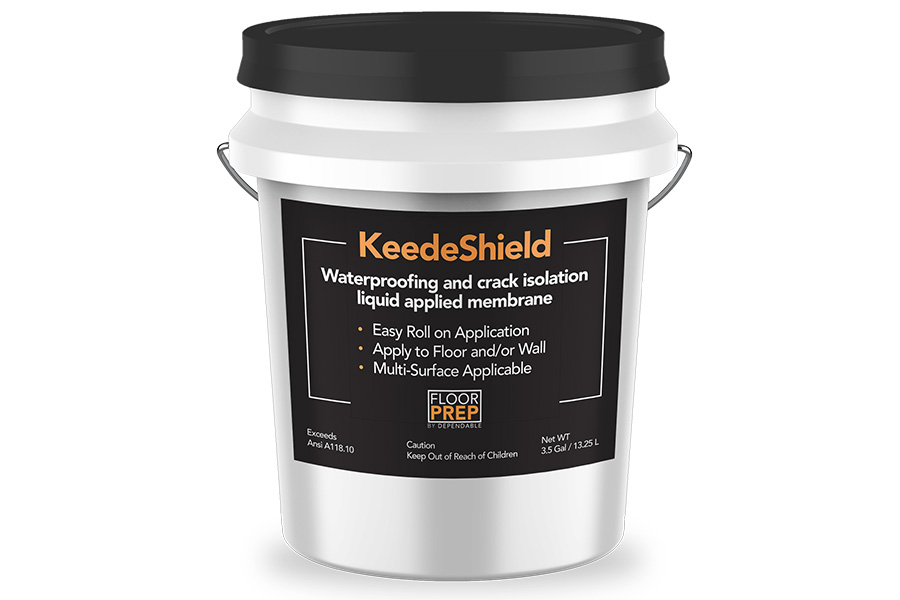KeedeShield®
KeedeShield® is an easy to use, rapid drying liquid applied waterproofing membrane for crack-isolation and waterproofing applications. KeedeShield® can be applied to walls, floors, and most irregular surfaces. KeedeShield® is suitable for use on interior or exterior commercial, industrial and residential tile and stone installations. Apply KeedeShield® by roller, trowel or sprayer to create a continuous water and moisture barrier with excellent adhesion. KeedeShield® bonds to metal, PVC, stainless steel and ABS.
- KeedeShield® is a single component compound that may be used directly from the container with no mixing required
- Applied cold by airless sprayer, roller, brush, or trowel
- Superior flexibility of KeedeShield® allows expansion and contraction with substrate, without cracking or becoming brittle
- No catalysts are necessary
- Non-flammable and solvent free
- Excellent adhesion in addition to elastomeric qualities makes the use of protective covering prior to backfilling unnecessary (unless backfill contains crushed rock)
- Exceeds ANSI A118.10
- Interior surfaces and exterior concrete/masonry surfaces
- Between slabs, such as parking decks, roof decks, or courtyard areas over subterranean parking
- Exterior walls or foundations and basements or other structures that are to be backfilled
- Inside planter boxes
- Under terrazzo or tile floors
- Under shower pans, kitchen, laundry, and bathroom floors.
- Inside elevated swimming pools or hot tubs.
- Countertops and facades
- Meets and exceeds the requirements of A.N.S.I. 118.10 and conforms to the requirements of ASTM C-836-89.
- Meets ANSI 118.12 High Performance (up to 1/8” (3mm) for crack isolation membranes.
- Meets Uniform Plumbing Code specifications for use as a shower pan liner. Listed with IAPMO R & T, File #4244 UPC®, ICC-ES ESR-1413.
- Meets low perm requirements for steam room vapor barriers per ASTM E-96 Procedure E.
Surface temperature must be 50-90F during application and for 48 hours after installation. All surfaces must be smooth, dry, sound and free of voids, projections, loose materials, oil, grease, curing compounds, and other foreign matter. Concrete decks should be cured a minimum of 7 days (preferably 28 days) before applying membrane. High, early strength and insulating concretes do not provide suitable substates. Float finished surfaces should be considered as the minimum finish for best results. KeedeShield® is best applied by airless sprayer, however it may also be applied by roller, brush, trowel, or caulking gun. All cracks over 1/16” in width must be filled and covered with KeedeShield®. A dry film thickness of 60 mils is recommended over concrete and block surfaces. Extremely porous substrates should be filled prior to coating or receive additional KeedeShield®. Coverage to obtain 60 dry mils is approximately 25 sq.ft/gal. Where a two coat application is preferred, two coats at 50 sq.ft/gal per coat are to be applied, allowing 24 hour cure time between coats.
Exterior and wet areas must feature sloping to drains without depressions that would impede drainage. All surfaces must be structurally sound, clean, dry and free from contaminants to ensure a proper bond. Newly applied smooth troweled concrete must be a minimum 28 days old and not be burnished (highly polished) as concrete must absorb. Scarify and flatten existing surfaces ensuring defects are repaired. Treat dormant cracks exceeding 1/8” (3 mm) in accordance with TCNA F125 or TCNA F125A.
Bonding to Lightweight Cement
and Gypsum Surfaces
Lightweight or gypsum-based materials must demonstrate a minimum of 2000 psi (13.8 MPa) compressive strength at the designated cure time. The underlayment must be dry and properly cured to the manufacturer’s specifications for permanent, non-moisture permeable coverings. Surfaces to be coated must be clean, structurally sound and subject to deflection not to exceed the current ANSI standards. Install expansion joints in accordance with local building codes and ANSI/TCNA guidelines. Prime all surfaces to receive KeedeShield® with properly applied manufacturer’s sealer (Platform P360, Primer MF, MF Topcoat/Sealer) or with a primer coat of KeedeShield®, consisting of 1 part KeedeShield® diluted with 4 parts clean, cool water. In a clean pail, mix at low speed to obtain a lump-free solution. Apply the diluted mixture of water and KeedeShield® (4-1) using a clean, fine tip broom to scrub in the primer solution. Keep the surface of the substrate wet for at least 15 minutes during application to ensure adequate and even distribution of primer coat. Apply the diluted KeedeShield® primer coat to the floor at a rate of 300 ft/gallon (7.5 M/L). Allow 1st coat/application time to dry before application of full strength KeedeShield®. For tile installations bonding directly to the substrate strongly recommended to apply at least one full coat of “undiluted” KeedeShield® to the “dry” primed area and allow to dry completely before tile installation work is to begin.
Vapor Barrier
When used as a vapor barrier, apply one full coat (70 sq. ft. per gallon) where vapor transmission is up to 8 lbs. per 1000 sq. ft. per day and two full coats (70 sq. ft. per gallon each coat) where vapor transmission is up to 12 lbs. per 1000 sq. ft. per day. Refer to ASTM F1869 for more information on Vapor Transmission Testing.
Movement Joint Placement
Do not bridge joints designed to facilitate or accept movement. Carry these kinds of joints through the finished tile work. Clean the joint and install an open or closed cell backer rod to the proper depth, per Tile Council Handbook, EJ171. Next compress sealant into the joint, coating the sides and leaving the sealant flush with the surface. When the sealant is dry, place bond-breaker tape over the joint. Apply a minimum 3/64” (1.2 mm) of KeedeShield® over the joint and the substrate, following the instructions provided previously. Install the tile work onto the membrane, but do not bridge the joint. After the tile work is properly set, follow the architect’s and manufacturer’s instructions to fill the joint with a specified color sealant.
Surface Preparation
KeedeShield® at Drains
Drains should have a clamping ring with open weep holes for thin-set application. Apply the membrane to the bottom of the flange. The drain should be fully supported, without movement, and should be even with the plane of the substrate. Apply the KeedeShield® membrane around drain. Embed a 12” x 12” (30 x 30 cm) fiberglass mesh into the membrane, making sure it does not obstruct the drainage weep holes. Then apply an additional coat of the membrane and smooth. After curing, clamp the upper flange onto the membrane and tighten. Use a silicone caulk around the flange where the membrane and the upper flange make contact. A toilet flange can be handled in much the same manner.
KeedeShield® as Crack Isolation Membrane
Force KeedeShield® into cracks with the flat side of the trowel, roller or brush. Using a 3/16”-1/4” (5-6 mm) V-notch trowel or 3/8” (9.5 mm) rough textured roller. Use the flat side of the trowel and flatten the ridges to form a continuous, even coat of material. The membrane should extend a minimum of the diagonal measurement of the tile beyond both sides of the crack. Gaps between plywood sheets and where floors meet walls must also be prefilled with suitable vertical patch (PrepPro Feather mixed low water). For continuous crack isolation, cover the entire substrate with KeedeShield® applied at a rate of 100 sq. ft. per gallon. To meet the requirements of ANSI A118.12, apply two coats of KeedeShield® at a rate of 50 sq. ft. per gallon each coat.
KeedeShield® as General Waterproof Membrane (ANSI 118.10)
Cracks to 1/8” (3 mm) should be prefilled before beginning the waterproofing application. Lightly dampen all porous surfaces. Use a 3/4” (19 mm) rough textured synthetic roller or a 3/16”-1/4” (56 mm) V-notch trowel and heavily precoat the corners and the intersections where the floors and walls meet, extending 6” (15 cm) on either side. For extra protection, embed a 6” (15 cm) wide fiberglass mesh into the membrane for changes of plane and for gaps 1/8” (3 mm) or greater. Apply each coat of KeedeShield® at a rate or 110 sq ft per gallon. If using a trowel, spread the material with the trowel held at a 45° angle, and then flatten the ridges. If using a roller, apply a continuous, even film with overlapping strokes. An airless sprayer may be used for the waterproofing application. The sprayer must produce between 1900 - 2300 psi, with a flow rate of 1.0 - 1.5 GPM and must have a tip orifice size of 0.025 - 0.029. Apply a continuous film with overlapping spray. The membrane appearance is dark blue when wet and dries to a black. It typically takes 1-1.5 hours to turn completely black. After the first coat turns black, inspect the film for integrity and fill any voids or pinholes with additional material. Apply a second coat at right angles to the first coat. To meet the requirements of IAMPO, Two coats should be applied at a rate of 80 sq. ft. per gallon each coat. In all cases the wetfilm thickness should not exceed 40 mils.
Product Application
Curing of Product
KeedeShield® is dry when it turns solid black, with no visible blue color. Typical drying time is 1-1.5 hours. Cool temperatures, high humidity or damp conditions can extend the drying time to 12 hours. After the second coat is applied and both coats are fully cured, the application area can be flood tested.
Protection
To protect KeedeShield® from damage after application and before installation of insulation or a wearing course, the membrane should be protected as soon as it cured with a suitable protection boards or sheet membrane. Protect from construction traffic, not for use as a wear surface.
If tile or stone will not be set immediately after curing, protect the membrane from rain, inclement weather and potential construction traffic damage. If delays longer than 72 hours are expected, cover and protect the membrane from extended direct sunlight (UV exposure). Care should be taken to prevent the application from becoming soiled or punctured during and after application.
Tile and Stone Installation
Install tile or stone with a FloorPrep polymer modified mortar (or equivalent) that meets ANSI A118.4 or A118.15 standards based on application requirements.
Maintenance
If KeedeShield®is damaged, it can be repaired by cleaning the surface and recoating it with KeedeShield®.




